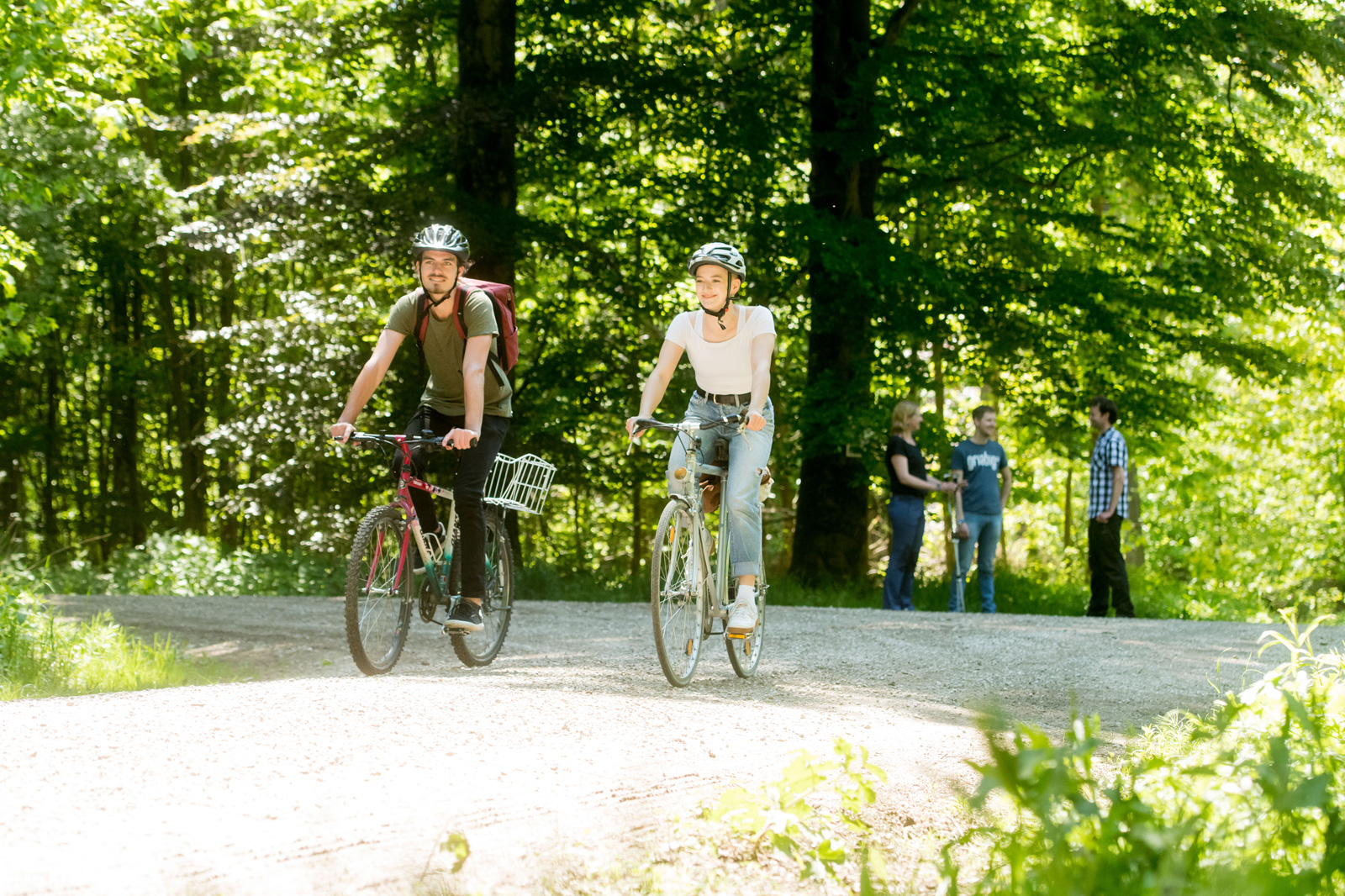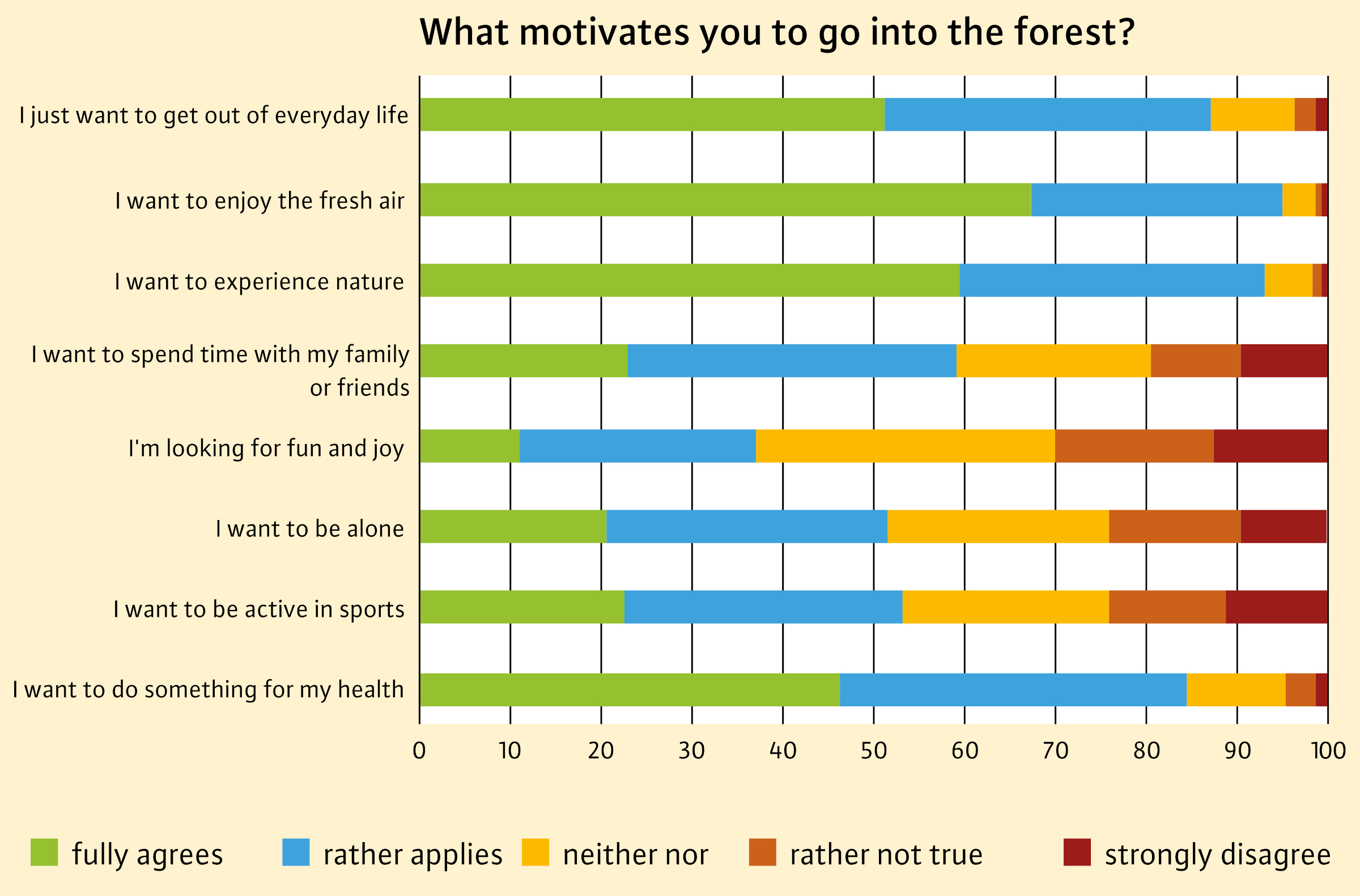Following similar studies carried out in Switzerland and Baden-Württemberg, the project “Socio-cultural forest monitoring Bavaria - WaMos Bavaria” was carried out in Bavaria in 2020. This representative survey of the population compiled and evaluated the responses of a total of 3504 participants to questions on the subject of the forest. The study gives an insight into the current social mood on important forest policy issues. For most people today, the forest is no longer a place of work, but a place for recreational activities.
Activities and intensity of visits to the forest
People who go into the forest mostly do so to go for a walk (89 %). This is hardly surprising and confirms the results of many studies on forest recreation. Besides this very frequently mentioned activity, people go to the forest to relax through being active (48 %), to experience nature (48 %) or simply to spend time together with their family (25 %). Mushrooms and berry picking is another reason for many to go out into nature (18 %). In addition to the activities mentioned above, the forest is used for physical exercise, including activites such as hiking, cycling and jogging (57 %). Just under 2.5 % of respondents stated that they (also) visit the forest for work. The main points of contact of the Bavarian population with the forest as a natural area are therefore in the context of leisure activities.
How intensively do visitors use the forest for their activities? In order to answer this question, it is useful to analyse the duration and frequency of visits. A “typical” forest visit lasts an average of 80 minutes. 90 % of the respondents spend up to two hours in the forest, 58 % up to one hour. A few visitors also carry out activities in the forest for three or even four hours (hunting, for example). When it comes to the frequency of forest visits, there is a clear seasonal effect in the use behaviour of the Bavarian population. In spring, summer and autumn, 13 % go into the forest every day, about a third go once or twice a week, or once or twice a month respectively, and 20 % less often or never. In winter, there is a decrease in the number of visits to the forest. Respondents who spend little time in the forest, regardless of the season, say that they mostly use other places such as their own garden or other green spaces for leisure and recreation. Otherwise, distance from the forest, health concerns (e.g. ticks) or qualms about being alone in the forest are also given as reasons for infrequent visits to the forest.
Reasons for visiting the forest
If people are asked why they go to the forest, the answer is very often because they want to enjoy the fresh air, to experience nature, to escape from day-to-day life, and to do something good for their health (Figure 3). Statements such as that the purpose of a forest visit is to have fun in the forest or for pleasure, to spend time with friends and family, to want to be alone, or to do some active sport are given less frequently than the reasons mentioned above. People’s motivation for visiting the forest can be divided into three clearly delineated motivation types:
- Recreation and the desire to experience nature: Forest visitors enjoy the fresh air and the opportunity to experience nature up close; they can get away from their day-to-day lives and switch off.
- The desire to have fun and do something active: visiting the forest is fun, you can do sports there (cycling, jogging, etc.) and socialise by spending time with friends and family there.
- The desire for solitude: in this context, the forest serves people as a retreat.
The statement that spending time in the forest is good for one's health can be related to all three motivation types. Nature lovers, people seeking recreation, sportspeople, and those seeking solitude in the forest are all motivated to go into the forest by the desire to do something for their health. The forest is a feel-good space that stimulates the senses (clean fresh air, nature-watching) and is good for people (relaxation, switching off, health).
Satisfaction with forest visits
The question of whether the Bavarian population is satisfied with their forest visits can be answered with a clear “yes” (32 % very satisfied and 54 % generally satisfied). 10% of the respondents are undecided (neither nor), and only a small proportion (4%) are dissatisfied. The high level of satisfaction is also reflected in the evaluation of the recreational effect of the forest. 62 % of the respondents are much more relaxed after a visit to the forest than before. 28% feel a little more relaxed. Only 8 % feel no effect or even negative effects (2 %). The experiences of most forest visitors in the forest are thus extremely positive.
If the Bavarian population is asked why the forest is so good for them, a differentiated picture emerges (Figure 4). As with the recreational motives, the things influencing people’s feeling of well-being in the forest can be summarised and brought down to two aspects. On the one hand, the absence of civilisation and immersion in an ostensibly “natural” environment is important. Respondents who emphasise this aspect for their well-being want to see little evidence of commercial forestry in the forest (67 % judge this to be important), want to experience the forest as a primeval forest (63 %), and want to walk along winding, labyrinthine forest paths (55 %). They do not want to meet many people in the forest (68 %), and for 67 %, a clear demarcation from civilisation is important for their recreational experience. On the other hand, they state that the aspect of order and accessibility of the forest is important for their sense of well-being in the forest. For this, they want forest paths to be clearly marked and laid out (51 %); the forest should offer views and plenty of light (32 %); it should look tidy (19 %); and it should also be easily accessible off the forest trails (32 %).
Some people thus relax in the forest because they are able to distance themselves from their everyday lives there while experiencing nature that seems “wild and original”. For others, it is important that the forest is a well-ordered, clearly structured, neat and tidy space where they can relax. The forest obviously fulfils both seemingly contradictory needs.
Disturbances during visits to the forest
The high level of satisfaction with visits to the forest is also due to the fact that most of the respondents do not feel disturbed by anything while they are there: 61 % cannot recall any negative experiences in the forest, 23 % state that there were occasionally unpleasant situations, and only 15 % confirm events that had a negative effect on their visit to the forest.
If those who recall disturbing situations are asked explicitly what negative experiences they had, the term “rubbish” is the one named most often (69 %). Conflicts with other visitors are also mentioned. For example, respondents find cyclists (63%), dog walkers (24%) or generally inconsiderate people annoying (44%). The presence of too many people in the forest is also rated negatively (20 %). Noise from road traffic (36 %) also impedes recreation. Only a few respondents view wood utilisation in the forest (10 %) and noise from forestry machines (11 %) as a nuisance. Similarly, the poor condition of trails (7%) and trail closures (4%) rarely seem to be remembered in a negative light.
Especially rubbish and conflicts with other visitors to the forest are key disturbance factors also confirmed by other studies. By using the term “rubbish”, forest visitors are suggesting that traces of civilisation are undesirable in the forest.
The bottom line
For the Bavarian population, the forest is a feel-good space. They experience the forest while out walking or during sports activities, and it is used for recreation locally. Relaxation, the chance to experience nature, sport and fun as well as the desire for seclusion and solitude are key motives drawing people to the forest.
If people are asked to evaluate their visits to the forest, the picture is extremely positive. The majority of respondents are satisfied with their visits to the forest and their recreational effect. Although people want as little noise, signs of operational management or other forms of human activity in the forest as possible for their well-being during forest visits, forestry activities are not seen as a central factor of disturbance. Other recreational users, or traces of civilisation such as rubbish, are however seen as nuisances.
Several studies have confirmed that the number of forest visits and thus the importance of the forest as a recreational space have increased due to the contact and travel restrictions during the Covid 19 pandemic. With an increasing number of forest visitors and the convergence of people with different interests, the risk of conflict also increases - especially given that it is not usually the whole forest area and network of paths that are used for recreation. Instead the focus of recreational activities is mainly on certain main routes. From that point of view, we can assume that visitor guidance and traffic safety will become increasingly important in forest management in future. It will only be possible to determine the extent to which the Covid 19 pandemic and the associated increase in forest visits have influenced the results of the “WaMos Bayern” survey by repeating the survey in 5 to 10 years’ time.
Summary
This article shows the importance of the forest as a recreational area for the Bavarian population. It is based on the representative survey carried out in the context of socio-cultural forest monitoring in Bavaria in 2020. The evaluation showed that a typical visit to the forest lasts an average of 80 minutes and takes place several times a month. People go into the forest more often from spring to autumn than in winter. 86 % of the respondents are satisfied with their forest visits; 90 % feel more relaxed afterwards. The forest is thus a feel-good space which, according to the respondents to the survey, helps promote their general state of health. Only a few feel disturbed by something - and if this is the case, the key things causing disturbance are traces of civilisation in the form of rubbish and conflicts with other forest visitors.




